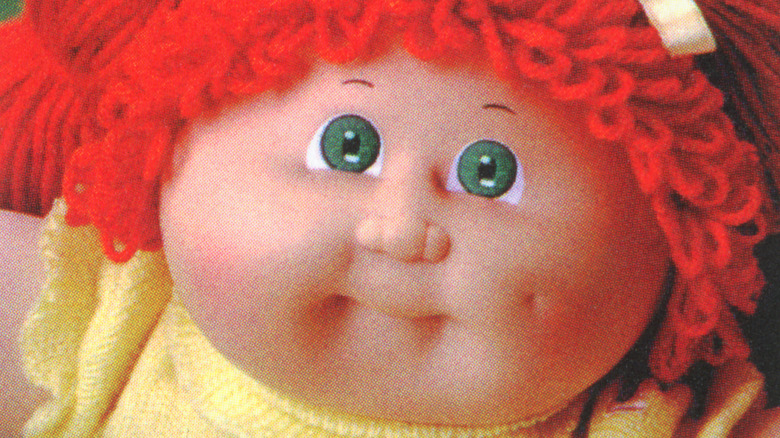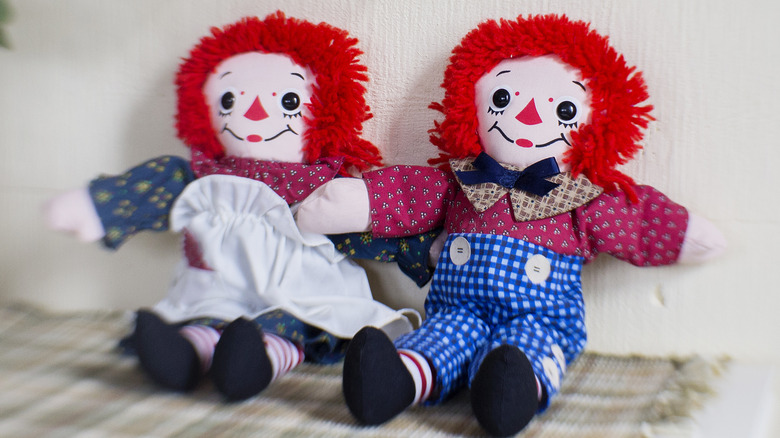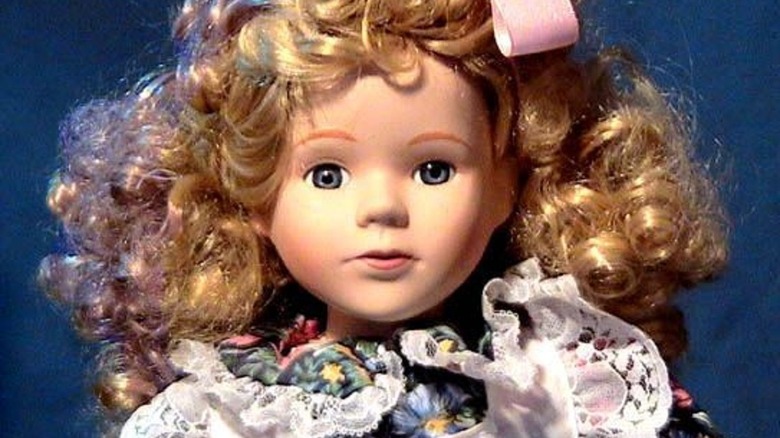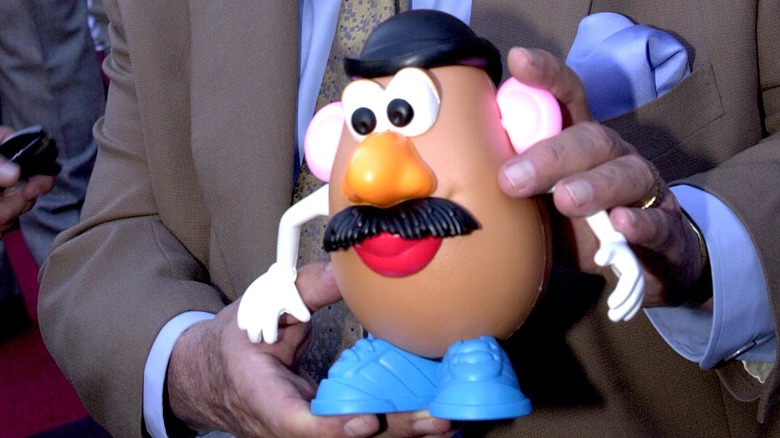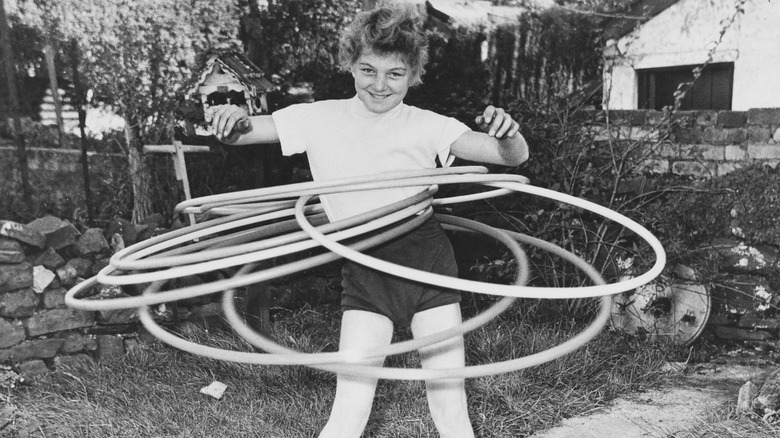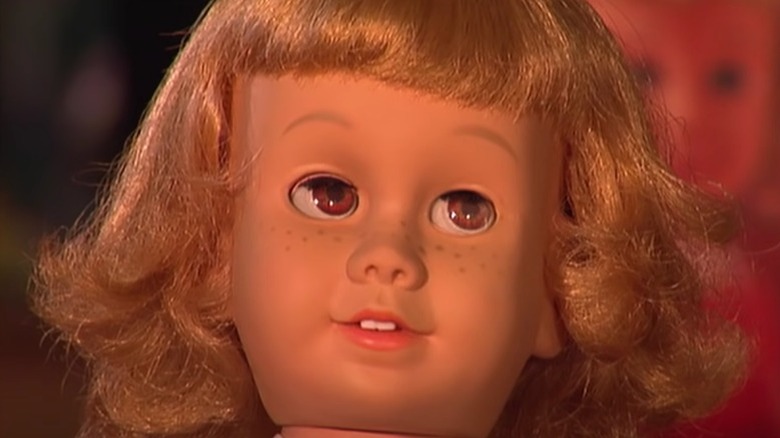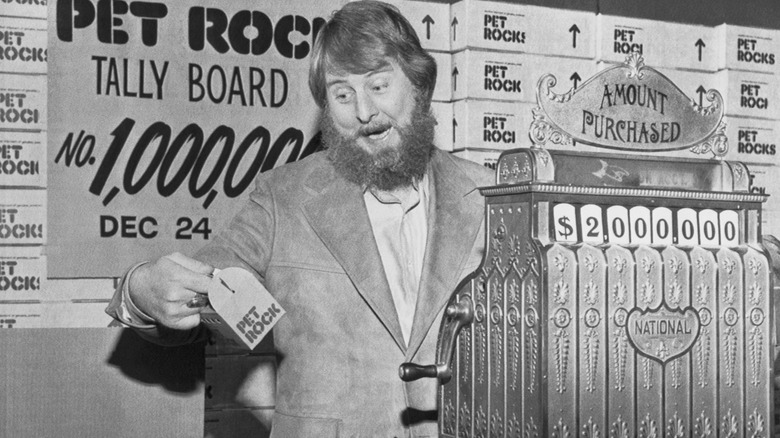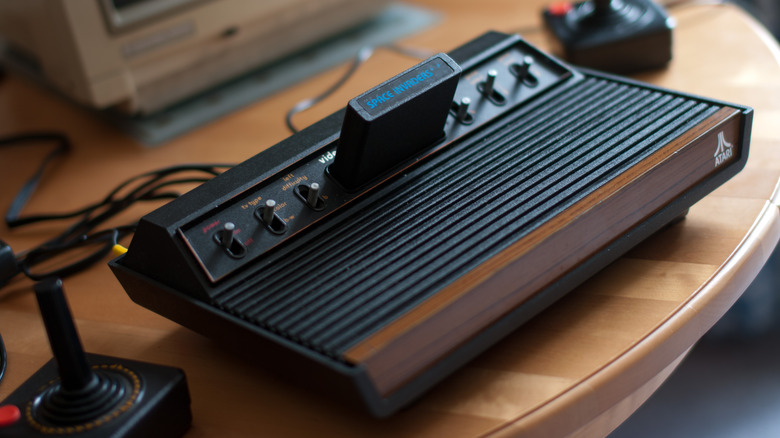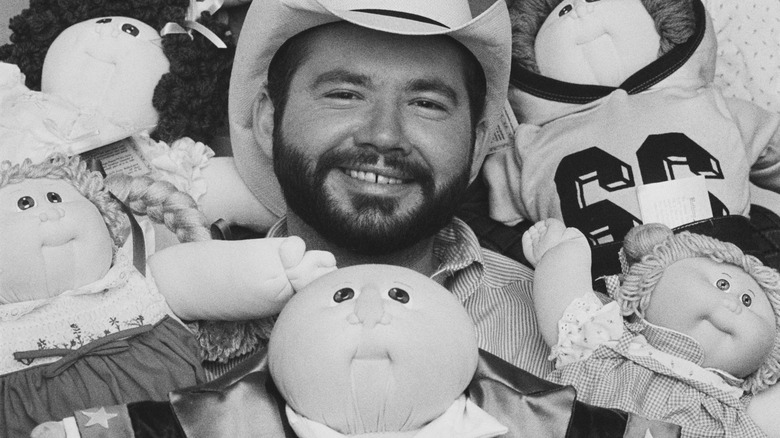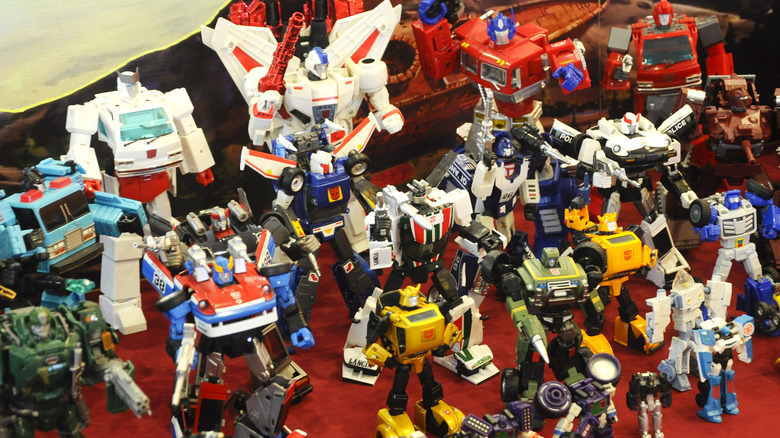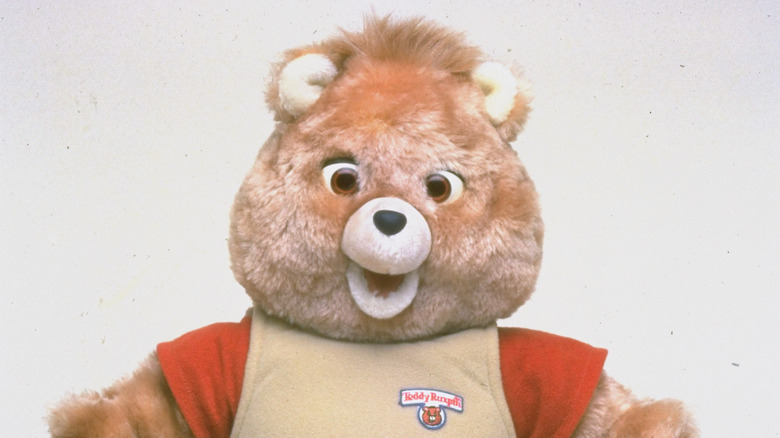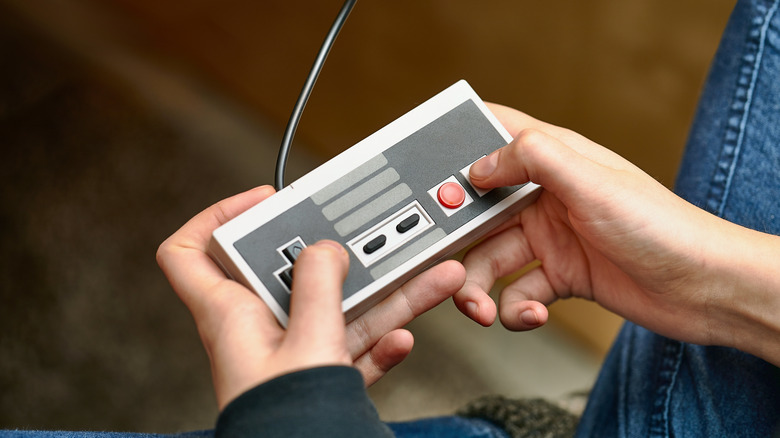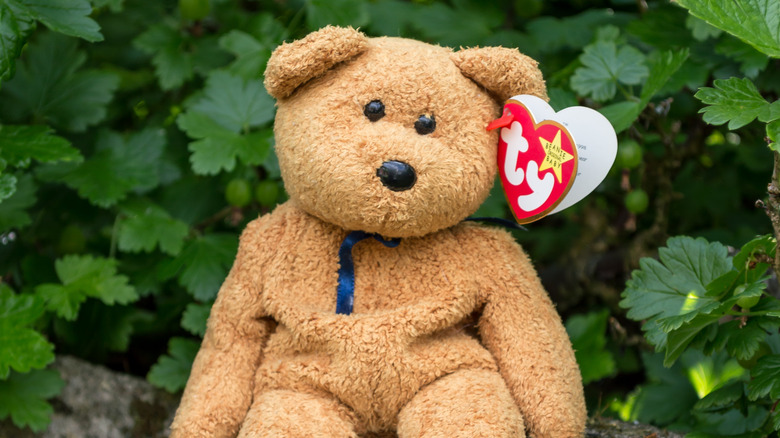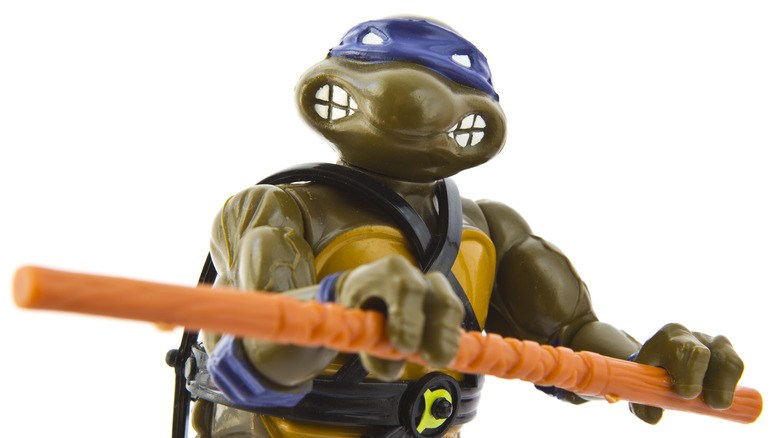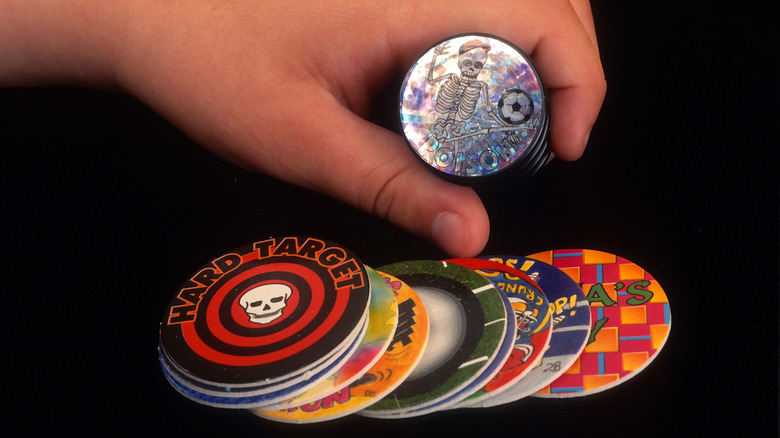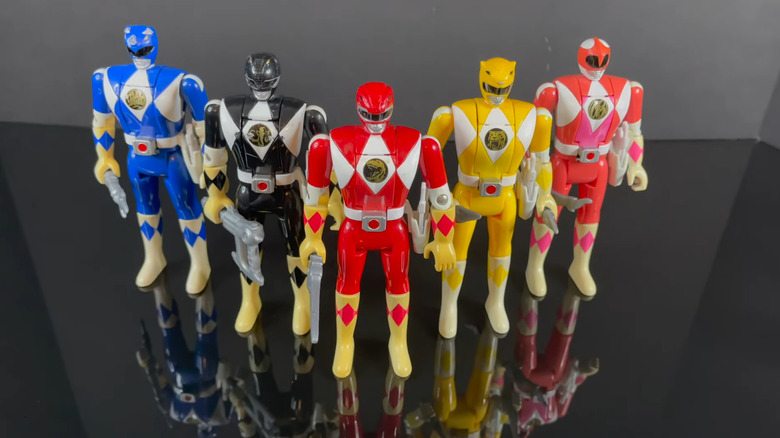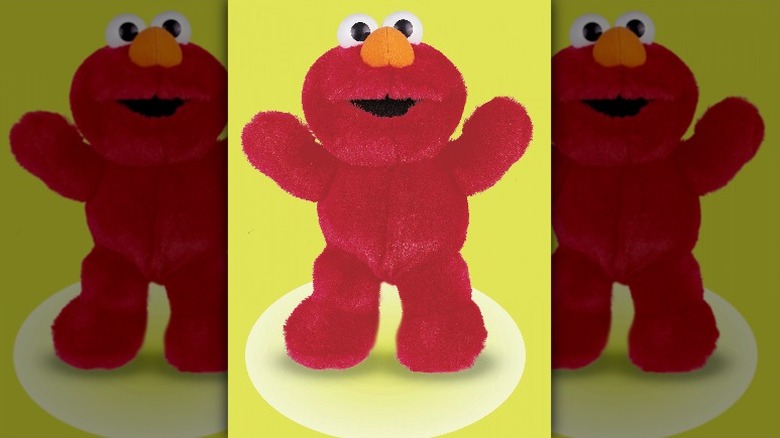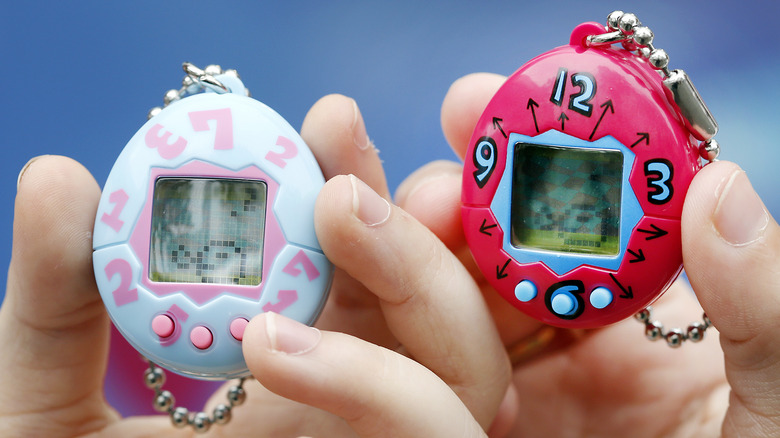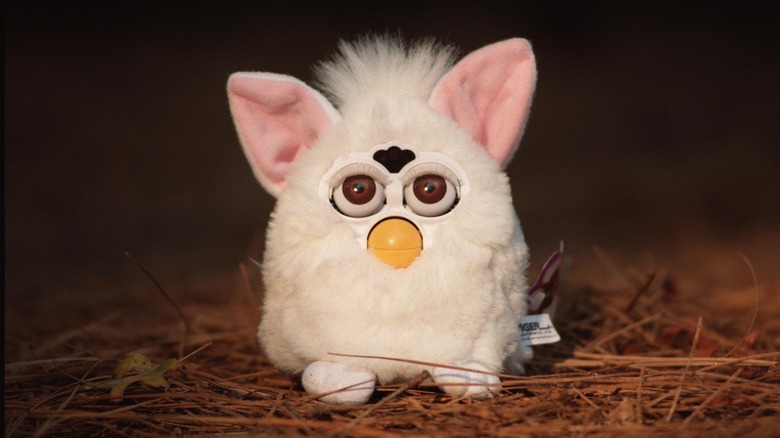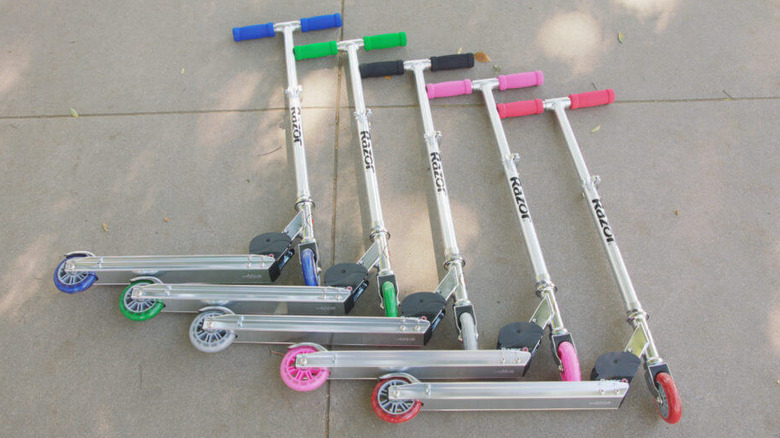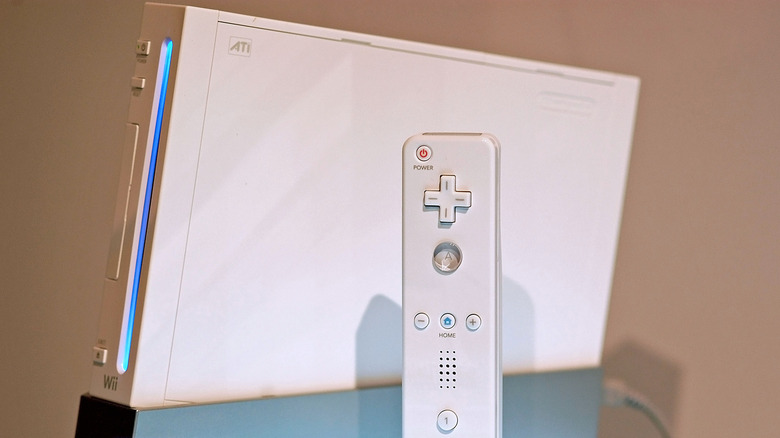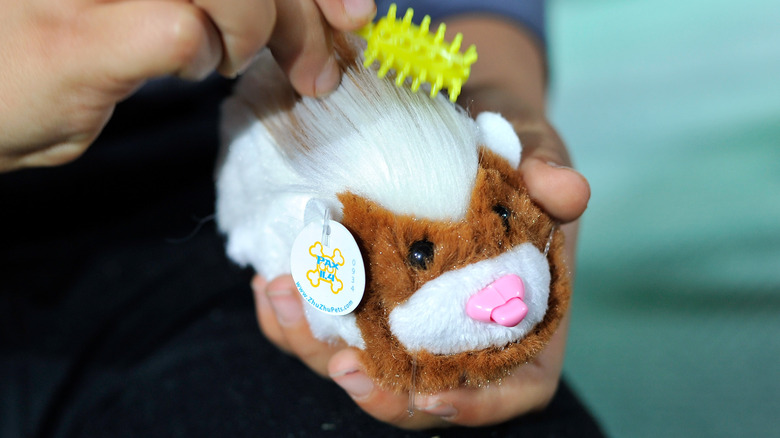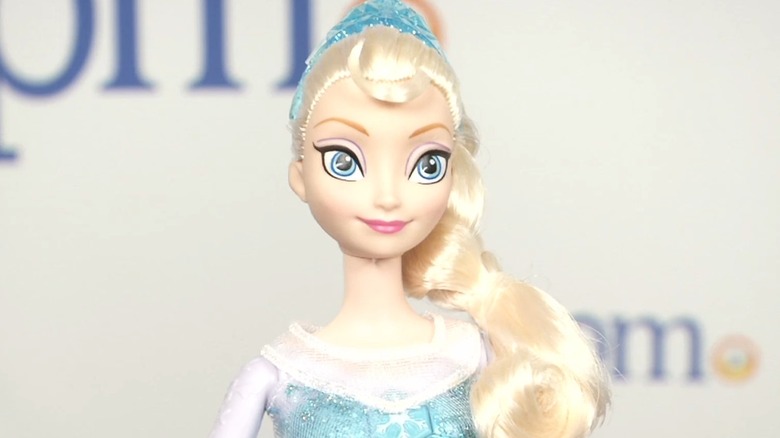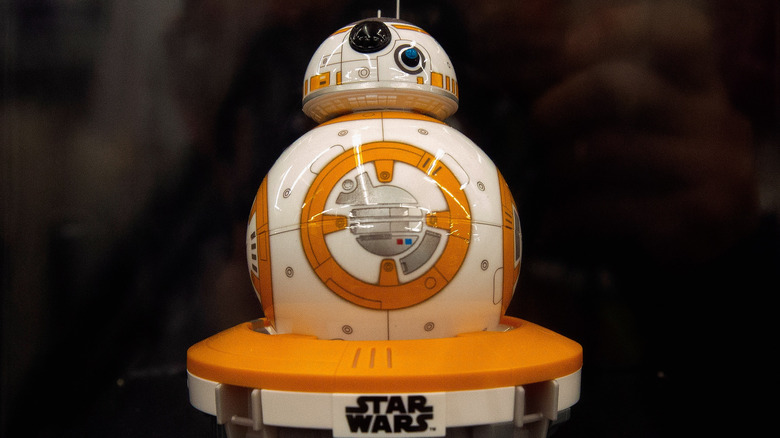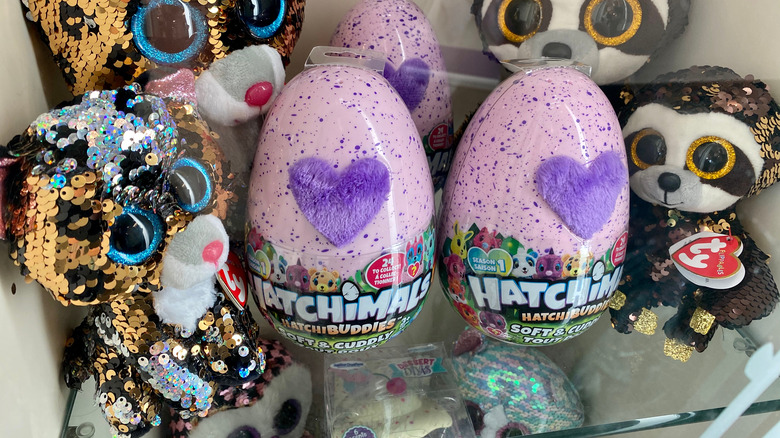The Biggest Christmas Toy Crazes In History
The pre-Christmas onslaught of new, hot holiday toys seems inevitable. Interestingly, the rush to buy the latest doll or even the next-generation gaming system is strictly a feature of modern history. The reasons are rather straightforward: Before the Industrial Revolution, toys were handmade or ad hoc. When time allowed, kids played with simple toys like rocks and sticks. Since everything was handmade, you weren't going to have mass production of identical Teddy Ruxpins. In addition, toys only took off as crazes after a modern media landscape and consumerism took hold. This is why, for example, while medieval Nuremberg may have been famous for its toys and dolls, there weren't any riots of young, upwardly mobile peasants trying to get their hands on the latest must-have spinning top.
Although the biggest Christmas toy crazes in history were modern phenomena, they were still epic in their scale. Let's take a look at some of these manias from oldest to most recent.
Raggedy Ann and Andy (1920)
Raggedy Ann is one of America's most beloved dolls. According to Patricia Hall's biography of her creator, the illustrator Johnny Gruelle, the doll was first created in 1915. While cloth dolls have been around since antiquity, Gruelle purposefully designed Raggedy Ann as a marketable commodity with "vulnerable expression, mismatched attire, and turned up toes."
The doll did well, especially since Gruelle had accompanying illustrated stories that promoted the toy; the first volume, 1918's "Raggedy Ann Stories," was published just in time to take advantage of that year's Christmas shopping season. But Raggedy Ann did not truly take off until 1920 with the introduction of her brother, Raggedy Andy. The dolls were produced by the Beers-Keeler-Bowman Company in Connecticut to pair with Gruelle's "Raggedy Andy Stories."
Ann and Andy became the power siblings of dolls in the 20th century. Gruelle continued to write over 40 Raggedy books that promoted the sale of his dolls. In the first century of the dolls' existence, over 60 million items of the Raggedy brand were sold, including dolls, books, and other toys. Even in recent decades, Raggedy books have exceeded sales of two million.
Yo-yo (1930s)
Yo-yos are the quintessential toy, despite the nagging myth that they were once deadly Filipino weapons. They have, however, existed since antiquity and were first introduced to the United States by a Filipino immigrant named Pedro Flores. What Flores did was loop the string around the axle of the yo-yo rather than have it just fixed to it, allowing for a variety of tricks. Flores opened a yo-yo factory in 1929 and even introduced yo-yo competitions. Even the name "yo-yo" is from Flores' native language, meaning "come-come."
In 1930, Donald Duncan, an entrepreneur who had introduced the world to Good Humor ice cream, bought Flores' business and trademarked "yo-yo." Duncan marketed the toy and it became a phenomenon throughout the 1930s — not just in the holiday season, but all year-round. In 1962, Duncan had sold 45 million yo-yos to the country's 40 million children.
However, Duncan's empire soon collapsed. Competitors won the right to use the word "yo-yo" in their products, and diminishing profits forced Duncan to go bankrupt in 1965. Yo-yos are, of course, still popular today.
Shirley Temple doll (1934)
Shirley Temple was the first major child star in the history of cinema. She started working in movies at age 3 and became known as a singer, dancer, and actress. In the 1930s, she regularly beat adult stars at the box office, including Clark Gable, Bing Crosby, and Joan Crawford.
Anything with Shirley Temple was saleable. In 1934, Ideal Novelty and Toy Company approached Temple and her family to produce a doll in her likeness. The company priced these 15-inch dolls at $3, which during the Depression was not chump change. That doll, however, was the small version. The dolls ranged in size up to 22 inches, which was sold for $7. Steep pricing aside, the doll was a hit, and Ideal sold over 50,000 Shirley Temples by Christmas that year. The company would continue producing the doll through 1940, with later revivals. Today, that $3 doll from 1934 can fetch a pretty penny on the collector's market, with the Antiques Roadshow pricing one doll at $650.
Slinky (1945)
Initially, the Slinky wasn't designed to be a toy. While working as a naval engineer in 1941, Richard James created a spring that could be used to steady equipment on ships. However, after witnessing the spring's unique movement and how it looked like it was walking, James realized it could be turned into a toy. He discussed his plan with his wife, Betty, and it was she who coined the name: Slinky.
For the next few years, James tried and tested various versions of the Slinky before receiving the opportunity to present his creation at Philadelphia's Gimbels store in November 1945. Within 24 hours, James sold out all 400 units on display — at $1 per Slinky. The excitement for this innovative spring only grew from there and it turned into one of the biggest Christmas toy crazes in 1945, as James sold 20,000 Slinkys and created an iconic toy that's still relevant decades later.
Mr. Potato Head (1952)
One of the most bizarre toys at the moment of its creation was Mr. Potato Head. George Lerner developed the idea in 1949 using real potatoes that could be embellished with add-ons to make a toy man. However, some manufacturers were afraid that using so much food for playtime would be frowned upon by parents who had just experienced the food rationing of World War II. But Lerner caught a break in 1951, when he made a deal with the toy company that would become Hasbro.
What catapulted Mr. Potato Head to fame was the very first toy television commercial as part of its launch in 1952, helping it become one of the must-have toys that Christmas. By the end of the year, 1 million Mr. Potato Heads were sold at 98 cents a kit (which lacked a body since you'd buy that at the grocery store). By the next year, Mrs. Potato Head, Brother Spud, and Sister Yam were introduced. The Potato Head parts were expected to be installed in actual potatoes until the 1960s, when regulations and complaints about shoving plastic pieces into rotting vegetables forced Hasbro to create the familiar plastic spud body that we know today.
Hula Hoop (1958)
Big hoops made out of various materials have been used as playthings since antiquity. Around 5,000 years ago, Egyptians wove reeds into circles that they played with using a stick. Hoops made of grapevines were used by the ancient Greeks for exercise. The list goes on, but it was British sailors who saw Native Hawaiians using hoops with the movements of their traditional hula dance, and added the term "hula hoop" to the lexicon.
However, it wasn't until 1958 that the toy company Wham-O entered the game, which had burst onto the scene the prior year when they sold the first Frisbee. The company obtained the rights to produce a plastic hula hoop in the United States, and the $1.98 toy was a ludicrous hit. Wham-O sold approximately 100 million hula hoops in its original version and, while the fad quickly ended, hula hoops have never quite gone away.
Chatty Cathy (1960)
First offered in 1960 by Mattel, Chatty Cathy was a revolutionary toy. As detailed by David Mansour in his book "From Abba to Zoom," this little-girl-next-door doll had a secret weapon: She could speak. Chatty Cathy could utter 11 different phrases when the "Chatty Ring," which was attached to a string on her back, was pulled. Children grew up hearing Cathy saying, "Will you play with me?" or "I love you" or "Please brush my hair." There were several variations of the Chatty Cathy doll which saw stellar sales through the decade. The doll was also the inspiration for the very creepy "Talky Tina" episode of "The Twilight Zone." Nearly a million children enjoyed chatting with Cathy in 1960, and follow-up Chatty dolls soon entered the market, including the bespectacled Charmin' Chatty, Singin' Chatty, and twins Tiny Chatty Baby and Tony Chatty Brother.
Sales of Chatty Cathy declined after the doll saw a makeover in 1970 that introduced a new look, only nine phrases, and the voice of Maureen McCormick (Marcia from "The Brady Bunch"). McCormick, however, should not be blamed for Chatty Cathy's downfall.
Pet Rocks (1975)
Pet Rocks are not just illustrative of a toy craze, but they are also an example of marketing genius on the messed-up level of P.T. Barnum. In 1975, Gary Dahl (pictured), who was an advertising copywriter, had a brainwave after a night in a bar. He realized people like pets but don't like to take care of them. Thus, the Pet Rock was born. He bought a load of Mexican smooth beach stones at roughly a cent a piece and prepared to sell his "pet." He packaged the rocks in a faux pet carrier with a sardonic care instruction manual.
It was a phenomenon. Pet Rocks were introduced for the 1975 Christmas season and received much free advertising through television appearances and articles. Within months, 1.5 million Pet Rocks were sold, which were priced at $3.95 each. The packaging cost more than the rock, but Dahl still made a solid 95 cents profit on each Pet Rock sold. Dahl saw the whole Pet Rock fad as a light-hearted way to get past the Vietnam War and Watergate eras. He would later say (via CNN), "I think the Pet Rock was just a good giggle. Everybody needed a good laugh and the media ate it up."
Atari 2600 (1979)
Atari founder Nolan Bushnell saw into the future. With a history in electrical engineering and having worked at a carnival, his vision featured electronic games being enjoyed in the comfort of family homes. This led him to the creation of the innovative Atari Video Computer System (VCS), which hit stores in 1977. The device would eventually become known as the Atari 2600 in 1982 and kickstarted the home console revolution.
The Atari caught the attention of the public in the late '70s with the release of two games that had been arcade exclusives up until that point: "Pong" and "Tank." Ironically, sales for the console had been slow in the early years since consumers didn't know they were able to swap out cartridges, but the Atari sold over 1 million units in 1979. More impressively, it became one of the top-selling gifts over the Christmas season as everyone wanted to experience the power of arcade gaming in their own home and embrace co-op gameplay. The video game industry has never looked back.
Rubik's Cube (1981)
Created by Erno Rubik in 1974, the Rubik's Cube might well be humanity's greatest test. With over a billion possibilities, the color-coded puzzle can keep someone occupied for days, weeks, months, and even years. After Ideal Toy Company secured the license for the product, it exploded in worldwide appeal in the early 1980s, with approximately 200 million sales from 1980 to 1983.
In 1981, the hype around the Rubik's Cube peaked, becoming one of the top-selling toys of the Christmas season and contributing 25% of Ideal Toy Company's sales that year. Surprisingly, it wasn't only the cube that gift-givers sought out for their loved ones and friends, but also books on how to solve this complex puzzle.
The following year, the cube struggled to match 1981's success as video game fever and "E.T. the Extra-Terrestrial" merchandise took over. Even writer James Nourse, who penned "The Simple Solution to Rubik's Cube,” knew the cube had been a seasonal trend and would struggle to keep up the pace. Nourse told The New York Times how his book had been the subject of major interest in late 1981, but all the hype died down at the turn of 1982. "[A]ll the television and news publicity ended in January,” he said. ”Now, the interest as evidenced by the number of calls I've got is almost zero.”
Cabbage Patch Kids (1983)
Cabbage Patch Kids began their life as the "Little People." These were hand-stitched dolls created by Xavier Roberts (pictured) in 1977. Each doll was unique and contained its own birth certificate. In 1982, Coleco licensed the dolls and began manufacturing them as Cabbage Patch Kids, which landed on the shelves in mid-1983. These dolls were craftily marketed to parents and featured on "The Today Show."
By Christmas, demand for Cabbage Patch Kids was insatiable, while supply was pitifully low. In accordance with the twisted laws of Christmas supply and demand, chaos ensued. People would drive hundreds of miles to find the scarce dolls. Crowds of up to a thousand shoppers camped out for the dolls and when an insufficient amount arrived, riots broke out. Adults snatched Cabbage Patch Kids out of children's hands. A woman in Virginia was trampled and suffered a broken leg. A store manager at a Zayre department store in Wilkes-Barre, Pennsylvania, had to wield a baseball bat to keep the demonic Cabbage Patch shoppers at bay. And naturally, a black market was established by resellers who charged far above the $21 retail price of the doll.
The mania subsided after two years, but only after Coleco had sold $250 million in dolls, with a $300 million back order. Today, there is a healthy collectors market for these dolls.
Transformers (1984)
The Transformers first invaded America in 1984. These toy robots, produced by Hasbro but originating in Japan, converted to vehicles and then back to robot form. Heck, some transformed into boomboxes, others guns, one into a microscope, a cohort into dinosaurs, and then a handful into cassette tapes, for some weird reason.
Hasbro teamed with Sunbow Entertainment to create a popular cartoon series that premiered the same year as the toy, thus sealing the fate of the Transformers as a high (or low) of Gen-X culture. By Christmas, some stores were reporting shortages and one Fairfax, Virginia, woman sustained a sprained ankle after being trampled in a rush for Transformers.
Of course, there were critics of the cultural value of the evil Decepticons battling for power with the noble Autobots, with "America Toons In" author David Perlmutter commenting that it was all just meaningless conflict centered on characters that had none. However, Hasbro wasn't exactly aiming for artistic excellence; the company was just trying to sell robots to kids. It worked. Borne on the success of the Transformers, Hasbro's revenue increased in that time to nearly $1 billion.
Teddy Ruxpin (1985-1986)
Before "Five Nights at Freddy's" put the fear of rogue animatronic bears in everyone, Teddy Ruxpin ruled the mid-'80s. The $70 toy dominated toy sales while also receiving his own animated series and movie. The talking and singing bear became the must-have gift for both the 1985 and 1986 holiday seasons, as every kid wanted Teddy to be their new best friend on Christmas morning.
Due to an aggressive marketing campaign, Teddy Ruxpin became the top-selling toy of Christmas 1985 and finished in the top three the following year. In addition, it had parents scrambling to various stores, trying to find any place that might have this happy-go-lucky bear in stock. Even in the 1986 holiday season, it wasn't easy to find Teddy in stores as kids continued to put him on their Christmas wish lists.
On the commercial front, Teddy Ruxpin proved a force to be reckoned with, lifting his parent company Worlds of Wonder Inc. to record-breaking success over the next two years. The company posted $327.4 million in sales in 1987; however, it racked up nearly as much in debt and soon faced bankruptcy.
Nintendo (1986)
After the boom and bust of gaming systems in the early 1980s, most prominently Atari, it seemed that the gaming industry was dead. But gaming was just in a state of hibernation. In 1985, the Nintendo Entertainment System (NES) was introduced. The term "entertainment system" was deliberately chosen by Nintendo, since video games had been given a bad rap and retailers wouldn't touch them. What's more, Nintendo made some very pointed business decisions, including refusing to license out the right to make games for the NES console. This was a mistake Atari had made, resulting in so much gaming drivel. Furthermore, the original NES almost didn't make it to the U.S.
NES started off slow, only selling 50,000 consoles for that Christmas season. It was well received, but what really made Nintendo into a phenomenon was the introduction of "Super Mario Brothers" the following year. By 1987, 1.1 million NES consoles were sold, it had been one of Toys R Us' best-selling items for Christmas 1986, and Nintendo sales in 1987 were $750 million and growing. Nintendo remained the master of the gaming industry until fresh competition from the Sega Genesis started to diversify the field in the 1990s.
Beanie Babies (1990s)
Like the 1980s, the 1990s were subject to several intense toy crazes, and the Beanie Babies bubble was the first. They were cute stuffed toys produced by TY, the company headed by Ty Warner, and promoted as collectibles. This meant that certain models were actively "retired" in a deliberate — and successful — attempt to make the product scarce. This ethically questionable market manipulation generated monumental demand.
Adults, parents and non-parents alike, scooped up Beanie Babies wherever they could get them. An economic bubble swiftly developed where people were selling and buying the little stuffed animals for up to $5,000, although the toys only retailed at $5 each. In one case, a judge forced a divorced couple to separate their Beanie Baby collection, in person and on the floor of the courtroom.
Eventually, Warner's market manipulations led to inevitable collapse. Beanie Babies are now the subject of jokes, but Ty Warner was able to use the proceeds to buy the Four Seasons Hotel in Manhattan. Warner pleaded guilty to tax evasion charges in 2013; today, most Beanie Babies are worthless.
Teenage Mutant Ninja Turtles (1990)
Who would have ever thought that a franchise about four anthropomorphic ninja turtles named after Renaissance painters would become a billion-dollar franchise? Kevin Eastman and Peter Laird's "Teenage Mutant Ninja Turtles" took the leap from independent comic book series to cartoon in 1987, and everything changed. After the animated series debuted, Playmates Toys released an accompanying toy line that defied every odd and catapulted this peculiar-named franchise to astonishing levels.
As if rockets were strapped to the turtles' shells, the franchise exploded in popularity, culminating with euphoric success in 1990 after the release of the live-action film. In the U.S. alone, the Ninja Turtles were responsible for $400 million out of the total $685 million in toy sales that year.
Turtlemania washed over the world that Christmas season, too, as children wanted nothing more than to find Leonardo, Donatello, Raphael, and Michelangelo sitting under the tree so they could experience turtle power. In fact, the four heroes in a half-shell even made the news in Glasgow, Scotland, in November 1990, after their toys were stolen in a store robbery before a highly publicized sale. Parents and children might have feared the worst in the lead-up to the holiday season, but shoppers had time to find more "TMNT" toys and keep the spirit of cowabunga alive for their families.
POGs (1994)
Based on the Japanese game of Menko, pogs proved to be an unexpected hit of the '90s. With pieces no larger than the size of a milk bottle cap, this game would involve trying to flip an opponent's pog for keeps. Playing pogs became a popular activity during recess on school playgrounds as players tried to collect as many pogs as possible to build their own formidable collection. At the same time, pogmania spread over the world as brands released their own specially themed pogs featuring a host of well-known characters and mainstream franchises.
Over 6 million packages of pogs were sold in Canada in the month leading up to Christmas 1994. The craze even led to the manufacturer, Canada Games, predicting over $100 million in sales over the next year.
Unfortunately, the playground excitement caught the eyes of teachers, who viewed it as a form of gambling and witnessed disputes between children. This resulted in many schools around the world banning the game altogether. However, it soon fizzled out in popularity on its own, going on to be remembered as one of the strangest obsessions of the 1990s.
Power Rangers (1994)
"Mighty Morphin Power Rangers" debuted in 1993, connecting with an audience through its amalgamation of Zord battles, breezy storytelling, and more spandex than an '80s music video. Expectedly, kids went wild for all the merchandise, especially the action figure line, as the franchise carved out its own niche in pop culture.
The Power Rangers hit a new peak in popularity before the 1994 Christmas season, as Saban Entertainment — the show's creator — warned fans to be wary of fake toys being peddled as the real deal. The company itself committed more than $1 million to help combat the counterfeit market.
Yet, despite the crackdown on the fake goods, the Power Rangers struggled to keep up with the demand for the toys during the holiday season. Bandai America invested in 11 more factories as it produced 10 times more toys than it did in 1993's Christmas season. As impressive as the investment was, it couldn't keep up with what was happening as soon as the toys arrived. The shelves were emptied out, with Power Rangers figures and accessories being the gifts of choice. It got to the point where parents were lining up outside of stores in an attempt to get first dibs on whatever was left inside.
Tickle Me Elmo (1996)
Elmo is a beloved Muppet from "Sesame Street," but in 1996, he became the icon of Christmas greed in a mad frenzy that hadn't been equaled since the Cabbage Patch Kids riots. It started when Ron Dubren looked to create a doll that laughed when you tickled its tummy. Dubren's prototype was Tickles the Chimp, but Tyco wanted something with more cache. So they landed a licensing agreement with "Sesame Street" to use Elmo as a plush. The final product was a 17-inch doll that continued to laugh until it at last said, "Oh boy, that tickles!"
Tyco priced the doll at $30, which was high for the time. But an opportune appearance on Rosie O'Donnell's talk show gave the doll the promotional steroids it needed. In fact, Rosie gave away a free doll to each audience member. Tyco's stock of 400,000 dolls promptly sold out, and scarcity drove stampedes and sales of the doll via auction for thousands of dollars. Even the son of mafia boss John Gotti supposedly got in on the action when he was said to have bought a case of Tickle Me Elmos during a late-night visit to Toys R Us,
By the end of the holiday season, Tyco had sold 1 million Tickle Me Elmos; they'd sell 3 million more the next year. The doll brought "Sesame Street" out of a ratings slump and helped save the show.
Tamagotchi (1996)
In 1996, the same year that Tickle Me Elmo made headlines, one of the decade's strangest toy fads emerged in Japan. Reminiscent of the infamous Pet Rock, Bandai's Tamagotchi were digital pets that were kept on a keychain, which required periodic care from the pet owner through some touches of a button. The name itself comes from the Japanese term for "egg," which properly describes the oval shape of these digital pets. They also required more care than a Pet Rock since they could die if you didn't press enough — or the right — buttons. Within seven months of Bandai introducing Tamagotchi to the United States, it saw $150 million in sales. A hot toy for several years, its appeal eventually waned.
Bandai attempted to make a Tamagotchi comeback starting in 2019. Their marketing plan was highly based on a nostalgic appeal to millennials. As a niche market, it seemed to work: Over 80 million Tamagotchi units have been sold between 1996 and 2021.
Furby (1998-1999)
When it comes to annoying toy crazes, few were equal to Tiger Electronics' Furby. This animatronic toy, which looks vaguely like a combination of an owl and "Star Wars'" Salacious Crumb, responded to movement and noise with hoots, squawks, and random movement. Perhaps The New York Times put it best when it wrote, "If the Pet Rock and Tickle Me Elmo had mated, in a union sealed with a Mood Ring, they would have given birth to a Furby."
Furby was first introduced for the holidays in 1998. There was no off-Broadway for Furby in the toy world. It immediately went to the big show, debuting at FAO Schwarz in New York City. Very quickly, the store sold out and had a backorder of 35,000 Furbies. That year, 1.8 million units were sold.
This, however, was dwarfed by the 14 million that sold the next year. Within three years, 40 million Furbies had been sold. However, the fad faded fast and by 2005, Furby was a has-been. This has not prevented Hasbro, which bought Tiger Electronics, from attempting reboots of the toy starting in 2012. These versions developed different personalities depending on how they were treated. These too were a hit, but not quite as much as the original generation. There is a fairly strong market for vintage editions of this unique toy, and in 2023, Hasbro announced a 25th-anniversary Furby that plays K-pop.
Razor Scooter (2000)
From bellbottoms to the mullet, trends often repeat themselves throughout history, and the same holds true for toys. The kick scooter had already existed for over 100 years before it found popularity over the Christmas season of the year 2000. Thanks to a strong marketing campaign, compact design, and eye-popping colors, Razor Scooter found itself at the top of every kid's wish list and a sought-after product for retailers to stock.
While scooters continue to be popular Christmas gifts to this day, Razor produced lightning in a bottle in 2000. As such, no one was under any illusion that this was anything but an extraordinary seasonal trend and would fade away in due course. The company knew it too, but rode the wave and sold over 5 million units in six months. At the same time, the demand for Razor scooters opened up the market to other manufacturers during the holiday season — since the retail price for the Razor proved pricey at $100, there was a gap for cheaper scooters. Even so, Brookstone's spokesperson Gustavo Pena didn't think the competition harmed Razor's bottom line too much, telling CNN: "Kids historically want the real thing."
Nintendo Wii (2008)
Released in 2006, the Nintendo Wii knew it couldn't compete with the sublime computing power of the Xbox 360 and PlayStation 3, but it had an ace up its sleeve: motion-sensing controllers. This novelty added another layer of interactive engagement, as players would need to gesture and move in certain directions to play a variety of titles. The Wii turned into a global phenomena, becoming a mainstay at parties and establishing itself as the top-selling console of 2008 in the U.S., outselling the Xbox 360 by nearly 2 million units.
As Nintendo prepared for the 2008 Christmas season, then-president of Nintendo of America, Reggie Fils-Aimé, told Forbes the company believed it would have enough consoles to satisfy customer needs. However, his confidence didn't extend to the smash-hit title "Wii Fit," which had an unprecedented demand at the time.
"With 'Wii Fit,' I know we'll fall short," Fils-Aimé said. "That's a product we have consumers lining up for each morning outside of our Nintendo World store."
ZhuZhu Pets (2009)
Who wouldn't want a toy collection featuring plush robotic hamsters named Pipsqueak and Num Nums? Especially when they come with a variety of accessories such as cars and skateboards. In 2009, ZhuZhu Pets took the Christmas season by storm, as children wanted nothing more than to add these cutie pies to their toy collection. Retailing at less than $10, these toys were extremely affordable and had analysts predicting ZhuZhu Pets could become the next Tickle Me Elmo craze.
Cepia — the company behind ZhuZhu Pets — opened up another three manufacturing facilities in China to keep up with the demand for the product over the 2009 Christmas season. Even so, the toys flew off the shelves almost as quickly as they came in. Reportedly, Times Square's Toys R Us staff wouldn't even stock their shelves since the toys would be sold to customers as soon as the shipments arrived.
Expectedly, the reseller market took advantage of the high demand and low stock volumes, selling these products for up to $60 on sites like eBay — and desperate parents forked it over to avoid unhappy and disappointed children on Christmas morning.
Frozen's Elsa doll (2014)
In 2013, Disney's "Frozen" swept up the globe with its charm, having both parents and children memorizing the words to "Let It Go" and figuring out how to build a snowman. A year later, the animated film's popularity hadn't waned, as the Elsa doll became one of the most in-demand toys for Christmas 2014. The singing Elsa doll even trumped Barbie as the intended Christmas purchase for that year, the first time in history that Mattel's moneymaker had been displaced as the chosen one.
Naturally, parents scrambled to ensure their children would receive the hottest gift of the holiday season, but this also resulted in a physical skirmish at a Dublin toy store, evoking strong memories of Arnold Schwarzenegger's 1996 Christmas movie "Jingle All the Way." No one was arrested for the dust-up, but there were claims that individuals required treatment for their injuries.
The reseller market also took note of the spike in popularity of the Elsa doll and milked it. Reportedly, the dolls were going for twice their retail price on eBay, while the limited edition versions could cost anywhere from $7000 upwards.
BB-8 Droid (2015)
Since "A New Hope" was released in 1977, the "Star Wars" toy industry has grown into a juggernaut, with sales of merchandise being counted in the many, many billions and "Star Wars" toys becoming collectibles as soon as they fly off the shelves. As Christmas approached in 2015, fans eagerly awaited not only the first of a new trilogy — "The Force Awakens" — but also the inevitable onslaught of eminently collectible toys, one of which was based on the lovable spherical droid, BB-8.
Sphero's BB-8 App-Enabled Droid made a break from many past imagination-fueled "Star Wars" toys and embraced the rise of the smartphone, allowing the user to control it via an app. In fact, the toy did a whole lot of nothing without the app, but more than made up for it with a wide range of programmable actions. Even the eye-watering price of $150 dollars did little to dissuade buyers, with buzz over the toy beginning before it went on sale in September 2015, at which point it broke sales records for Sphero by selling at a rate of up to 2,000 per hour.
After the Christmas release of "The Force Awakens" passed and Santa was long gone, the phenomenal success of the rolling BB-8 toy had contributed to over $700 million in sales of "Star Wars" toys in 2015 alone. Sadly, for those looking to try one out today, the used market is their only option, as Sphero discontinued the product in 2018.
Hatchimals (2016)
On October 7, 2016, children's toy manufacturer Spin Master announced "Global Hatchimals Day," when it launched a hitherto secret new line of toys and set in motion the next Christmas-toy craze. The Hatchimals themselves were simple, consisting of an egg that, when interacted with, slowly "hatched" a furry toy. The novelty, clever marketing, and interactive nature of the toy all combined to create a perfect storm of frenzied parents competing to get one under their Christmas tree.
It didn't help that the manufacturer of Hatchimals couldn't get them on the shelves fast enough, even after shelling out on expensive airfreight shipments from Chinese factories. And the mid-2010s also brought social media into the mix, which at times turned vicious and very much counter to the festive spirit. Reportedly, even parents who posted innocuous requests for information on Hatchimal availability were greeted with hateful comments, but the worst was reserved for those trying to turn a profit by reselling batches, even for charitable purposes. Despite the best efforts of many parents, with some even entering lotteries and raffles to obtain a Hatchimal if they couldn't afford the inflated prices of online scalpers, the shortage was not alleviated until the following year.
